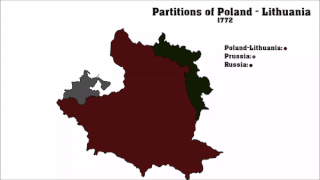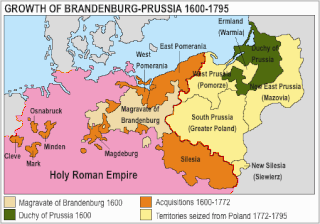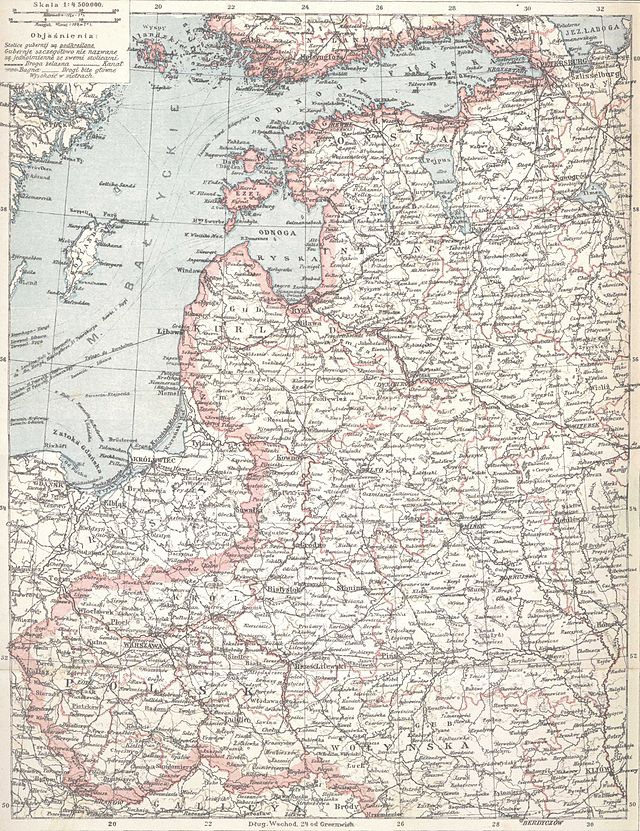Loading AI tools
From Wikipedia, the free encyclopedia
Following three consecutive partitions of Poland carried out between 1772 and 1795, the sovereign state known as the Polish–Lithuanian Commonwealth disappeared from the map of Europe. In 1918 following the end of World War I, the territories of the former state re-emerged as the states of Poland and Lithuania among others. In the intervening period, the territory of the former Polish–Lithuanian Commonwealth was split between the Austrian Empire, the Kingdom of Prussia and the Russian Empire. These powers subdivided the territories that they gained and created new toponyms for the territories conquered. The subdivisions created were complicated by changes within those empires as well as by the periodic establishment of other forms of the quasi-Polish provinces led by a foreign head of state.
| Territories of the Polish-Lithuanian Commonwealth during Partitions | |
|---|---|
 The three Partitions of Poland 1772–1795 | |
| End of the Commonwealth | |
 Disappearance of Poland from the map of Europe | |
| Territorial losses | |
| Total losses | 741,000 km2 |
| To Prussia | 149,000 km² with 2.6 million people |
| To Russia | 462,000 km² with 3.5 million people |
| To Austria | 130,000 km² with 3.85 million people |
The below subdivisions do not cover the administrative divisions of the French vassal state created by Napoleon - the Duchy of Warsaw. See subdivisions of the Duchy of Warsaw (1807–1815). For the administrative division of the Polish-Lithuanian Commonwealth before its final third partition, see subdivisions of the Polish–Lithuanian Commonwealth. For the subdivisions of the lands awarded to the Russian Empire, see subdivisions of Congress Poland (1815–1918) and History of the administrative division of Russia. For subdivisions of the lands awarded to the Kingdom of Prussia, see Provinces of Prussia.

The Austrian Empire, known from the second half of the 19th century as the Austro-Hungarian Empire, annexed territories of the former Polish–Lithuanian Commonwealth in the First Partition (1772) and the Third Partition (1795).[1] The territories obtained were subdivided into:
In the First Partition, the Austrian Empire received the largest share of the Polish population, and second largest land share (83,000 km2 and over 2.65 million people). Austria did not participate in the Second partition. In the Third Partition, Austria annexed 47,000 km2 of territories with 1.2 million people. Overall, Austria gained about 18 percent of the former Commonwealth's territory (130,000 km2) and about 32 percent of its population (3.85 million people).[1] From the geographical perspective, much of the Austrian partition corresponded to the Galicia region.




The Kingdom of Prussia (known from second half of the 19th century as German Empire) annexed territories of the former Polish–Lithuanian Commonwealth in all three partitions.[1] The territories obtained were subdivided into the following.[2]
In the First Partition, Prussia has received 36,000 km2 and about 0.6 million people. In the second partition, Prussia had received 58,000 km2 and about 1 million people. In the third, similar to the second, Prussia gained 55,000 km2 and 1 million people. Overall, Prussia had gained about 20 percent of the former Commonwealth territory (149 000 km2) and about 23 percent of the population (2.6 million people).[1] From the geographical perspective, much of the territories annexed by Prussia formed the province of Greater Poland (Wielkopolska).
The Russian Empire which acquired the territories of the Kingdom of Poland, the Grand Duchy of Lithuania and the Duchy of Courland and Semigallia in all three Partitions,[1] divided the former territories of the Commonwealth by either creating or enlarging the following guberniyas.[2]
After the Congress of Vienna in 1815, the Russian Empire created a separate entity called Congress Poland. See administrative division of Congress Poland for details. Territories in the Russian partition which were not incorporated into Congress Poland were known as the Western Krai (combination of Northwestern and Southwestern Krais), and in Poland as the taken lands (Polish: ziemie zabrane).
The Western Krai comprised the following lands of the Commonwealth:
It consisted of 9 guberniyas: six Belarusian and Lithuanian ones that constituted the Northwestern Krai (Vilna Governorate, Kovno Governorate, Grodno Governorate, Minsk Governorate, Mogilev Governorate and Vitebsk Governorate) and three Ukrainian ones that constituted the Southwestern Krai (Volhynia Governorate, Podolia Governorate and Kiev Governorate).
The Duchy of Courland and Semigallia was transformed into Courland Governorate (Government of Courland) and grouped with the Baltic governorates also known as Governments of Ostsee.
In the first partition, Russia gained 92,000 square kilometres (36,000 sq mi) and 1.3 million people. In the second, 250,000 km2 and 1 million people. In the third, 120,000 km2 and 1.2 million people. Overall, Russia had gained about 62 percent of the former Commonwealth territory (462,000 km2) and about 45 percent of the population (3.5 million people).[1]
During World War I (1914–1918), much of the territories became occupied by the Central Powers (primarily, German Empire) and became administered by the Ober Ost.
Seamless Wikipedia browsing. On steroids.
Every time you click a link to Wikipedia, Wiktionary or Wikiquote in your browser's search results, it will show the modern Wikiwand interface.
Wikiwand extension is a five stars, simple, with minimum permission required to keep your browsing private, safe and transparent.